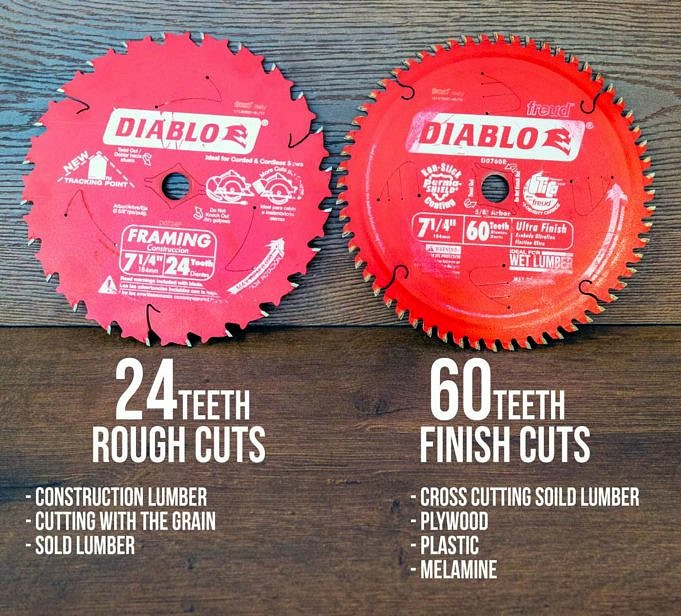Miter saw blades are classified by the number of teeth on the blade. include 60 vs 80 Tooth Miter Saw Blade.
A 60 tooth blade is great for general purpose use, while an 80 tooth blade is designed for cutting more intricate angles and finer details.
Which one should you pick for your next project, and why? Let’s take a closer look to see the pros and cons to help you make a decision.
Mitersaw Blade Anatomy
The five primary components of a typical miter saw blade are:
1) The Body
2) Arbor
3) Teeth
4) Raker (sometimes called gullet)
5) Back
The body of the blade is simply that, the solid metal portion that you mount to the saw. The arbor is where you attach the blade to the saw. The teeth are what do the cutting at the business end of the blade, while the raker (gullet) cleans out whatever debris has accumulated during a cut.
Many blades come with a backplate, which you can attach to your saw to keep everything in place.
60 Tooth Blades
60 tooth blades are great for general purpose use. They excel at cutting wood, plywood, plastics, and composites. This is because the 60-tooth blade has a wider gullet (the space between the teeth), which allows for more sawdust to be absorbed during a cut.
If you are working on-site or in an environment where cleanup is difficult or time-consuming, then a 60 tooth blade will probably be your best choice.
A 60 tooth blade offers an excellent combination of being able to cut quickly while also producing nice clean cuts with very little tear-out. Because they have fewer teeth there is less chance of the material binding in the sawblade so they are great for finishing work when accuracy matters most.
An added bonus is that the larger gullet of a 60 tooth blade makes it easier to use your saws laser guide.
80 Tooth Blades
However, 80 tooth blades are more adept at cutting through complex materials such as melamine and plastics. These blades might also chip or break with a lower tooth count. The smaller tip radius of an 80 tooth blade enables it to reach into tighter spaces than a 60 tooth blade can.
They are ideal for cutting moldings and coping doors, as well as finer cuts in thicker materials without burning the edges.
A 80 tooth blade will have a smaller gullet, which means that they will produce more sawdust when cutting wide materials like plywood and MDF. However, cleanup will be easy because of the smaller radius. This will result in finer, easier to manage sawdust.
Keep in mind that a 80-tooth blade is more likely to cause tear-out, especially if the material is susceptible to being chipped or splintered during a cut.
Who should go with 60 tooth Blades?
If you are cutting sheet goods like plywood, MDF, particleboard, etc., then a 60 tooth blade will get the job done without costing you any unnecessary money or time spent on maintenance.
A 60 tooth blade can handle just about everything except for very fine detailed cuts in thicker materials where burn might be an issue.
Who should buy 80 tooth blades?
An 80 tooth blade is recommended for cutting thin sheets of melamine, plastics and exotic woods such as Ipe. This will prevent any chipping or splintering.
If you are cutting moldings or coping doors and windows, then an 80 tooth blade is ideal because it will not leave as noticeable a saw mark as a 60 tooth blade.
Either way, if youre trying to cut very intricate shapes with your miter saw, then an 80 tooth blade is almost always the best choice for achieving professional-looking results.
Conclusion
You can choose which blade suits your needs best. Each blade has its pros and cons so choose the one that is most important to you.
If you want a blade that can handle more delicate cuts, go with the 60-tooth option. The 80-tooth model is for you if you require a blade that can cut through harder materials more quickly.
FAQs
What is precision?
- Your fence’s quality and accuracy.
- Your saws miter index accuracy.
- Your saw blade’s quality and hardness.
- And the visibility and steadiness of your hands during the cut.
Precision is the ability to fit two pieces together correctly when they are joined in glue-up. It is affected by a number of variables including:
As far as I know, there are only two ways to improve the accuracy of your cuts:
1) A higher-quality saw with tighter tolerances between its adjustments will allow it to cut more accurately.
2) Choose blades that have higher manufacturing tolerances. This can allow you to produce smaller cuts than what your saw is capable of producing.
If you have a miter saw with a blade of 60 teeth and a fence that is exactly 90 cm from the blade, you can make a cut in flat material. Then glue the pieces together.
If the material is not as stiff or has some give, it can cause your saw to deflect by a few thousandths. This will result in each piece having a small gap that can be difficult to see with the naked eyes.



